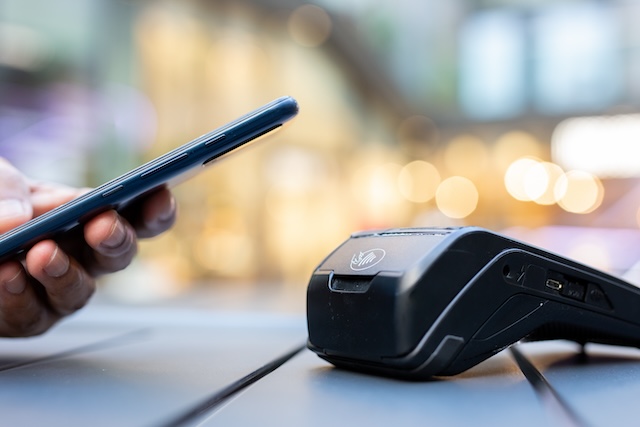Once upon a time, the question “How would you like to pay?” yielded very few interesting answers. But recent years have seen a proliferation of new payment methods, some using smartphones, including digital wallet services from Apple, Google and Samsung, but also a growing number of wearable payment devices including smart watches, Fitbits, jewellery, and even items of clothing.
NFC payment wearables
Wearable payment devices are not gimmicks: they offer fast, convenient and secure ways to pay. Most are based on near field communications (NFC) technologies, enabling smart payments, processed automatically via secure links between the device, payment terminal and the consumer’s bank account and/or digital wallet. Smart payments also generate data that a card issuer, bank or brand could use to inform personalised services. Wearable payment devices can also be used for other purposes, including ticketing for transport or events, access control for buildings or vehicles, and digital identity verification.
Some wearables, such as smart watches, are “active”: a shopper can authenticate their identity using the device itself, with a PIN or a biometric, for example. Others, such as bracelets or rings, are passive: they do not need charging, but carry a chip which connects to payment terminals via NFC, with transactions authorised in advance through a digital wallet or banking app.
Future of payments technology — Consumers demand speed, convenience and security when it comes to payments, which puts technology in the driving seat
In both cases, tokenisation and encryption shield payment data and customer details, making this a more secure way to pay than using a card, in theory.
Banks, card issuers and technology providers are all working to create more wearable payment devices, in markets around the world. In March 2023, the fintech Curve announced a partnership with wearables specialist DIGISEQ to make a range of wearables available to four million Curve users in 31 European markets. Barbara Sessa, senior vice-president, digital consumer products, Europe, at Mastercard, says it expects to be working with passive and active wearables in every market across Europe within the next two years. And this is a global trend: ResearchAndMarkets.com predicts that the global wearable payment device market, worth $52 billion this year, will grow to $137 billion by 2030.
Contactless payment wearable devices
Accenture global payments lead Sulabh Agarwal thinks the rate at which wearables are being adopted is linked to the growing popularity of some well-established wearable devices, such as smart watches or Fitbits. But there are other devices used primarily as payment devices that are also attracting converts, such as Keyble, developed by flywallet, an active NFC payment device protected by a fingerprint biometric, which can be inserted into watch straps, bracelets or key rings. There are also other types of bracelet-based wearables, such as those produced by Neos, OILI and Paycelet; along with rings from LAKS, McLEAR, or Wayve Pay.
“I think that among all the wearables, watches are the most promising from a consumer perspective,” says Agarwal. The global smartwatch market is projected to grow from $33.2 billion in 2022 to $130 billion in 2030, according to Vantage Research. The watches include Apple and Samsung smart watches – the latter is an Android-based option which can be used to make payments via magnetic strip payment infrastructure as well as NFC. Garmin smartwatches can make payments via the Garmin Pay platform and digital wallets compatible with Visa, Mastercard and other card schemes.
How Buy Now Pay Later technology works – Providers such as Klarna and Zilch are worth billions due to their accurate lending decision making. The reason? Artificial intelligence, a hundred or more data sources, and nudge theory
Other watches can be used as passive wearables: the SwatchPAY! solution uses a passive NFC chip to link to one of the owner’s payment cards; and is compatible with both iOS and Android.
Elsewhere, Fidesmo provides a technology platform for wearables including rings, bracelets and key fobs produced by multiple Original Equipment Manufacturers (OEMs). It is also working closely with wearonize, the platform behind other wearables services, including SwatchPay!
Fidesmo CEO and co-founder Mattias Eld says user data shows that people who use a wearable payment device regularly tend to do so for between 10 and 25 transactions per month; and that so far it is rings which have proved the most popular wearables with consumers. “You have it on your hand, you don’t need to charge it; it’s always near to the terminal,” he explains, comparing this to the need to open a wallet and get a card out, or to find and open your phone and an app.
Wearable payment technology
Other OEMs are experimenting with other form factors. Austrian company LAKS offers watches, bracelets, rings and key rings among its wearables, but also iron-on clothing patches and even a baseball cap. UK clothing company DressCode has developed the CashCuff shirt, incorporating a removeable NFC device in one of its cuffs, which the wearer can use as a passive wearable, accredited by Mastercard.
“For me, the crucial piece is the user experience,” says DressCode founder Andy Boothman. “It has to feel natural.” With the CashCuff, he says, “even if you’re carrying three coffees you could still put your hand on the terminal and pay”. He also points out how useful the technology could be for people with disabilities that make it difficult to use their hands.
Eld fears that the nature of global payments systems may restrict some potential innovations. “We need to allow more types of wearables and more brands to participate in payment systems, because otherwise you’re down to solutions provided by a relatively small set of companies,” he warns.
6 payments technology companies disrupting the sector – Here are some companies that are making waves in the payments technology space, bolstering transaction processes for businesses
But some may be relieved to see this might stop, or at least delay, adoption of more radical innovations. Walletmor has developed a system that involves an NFC device being implanted into an individual’s arm – a startling idea, with a hint of sci-fi. Visa and Mastercard appear unwilling to work with implants at present, so it could be a while before they become a mass market proposition.
But Boothman is convinced that we will continue to see more use of wearables in general.
“We love our phones, but there are times and places where it’s just not good to be having a £1,000 bit of equipment around,” he says. “There’s a desire among consumers for something more convenient. Some of the form factors are amazing: the technology, the security, is absolutely first class. There really is a lot of activity in this space.”
More on payments technology
A history of online payment security – Over the years, industry leaders in internet business transactions have worked to create complex systems for ensuring online payment security







